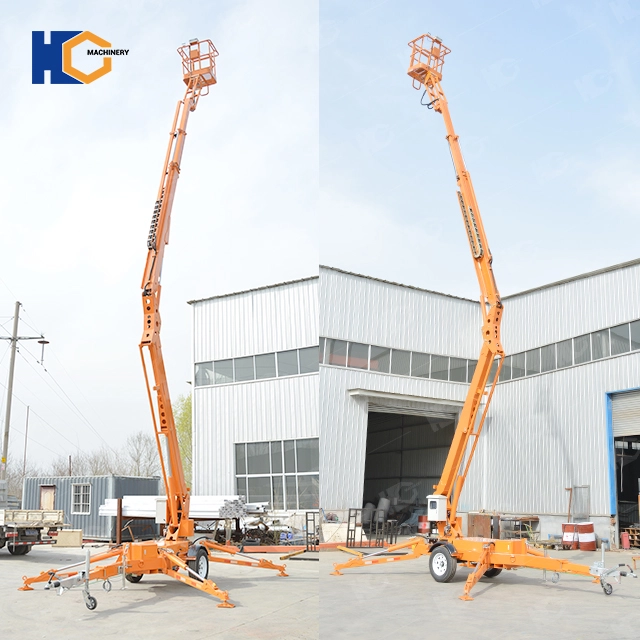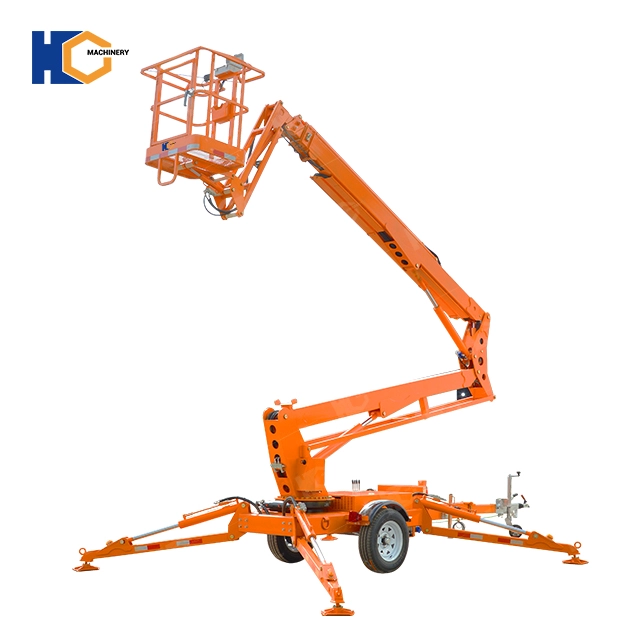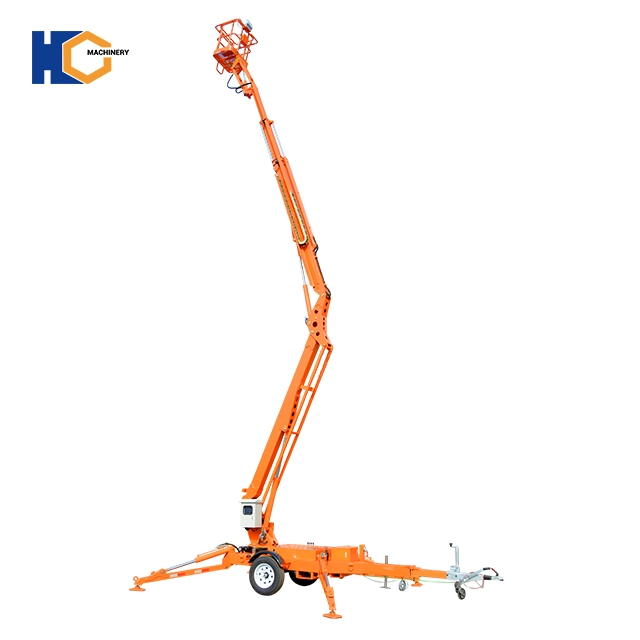The Versatility and Advantages of 20ft to 60ft Towable Boom Lifts
Towable boom lifts, ranging from 20ft to 60ft, are essential tools in a variety of industries, providing the reach and mobility needed for working at heights. These lifts, also known as trailer-mounted boom lifts, are designed to offer flexibility, safety, and ease of use for both indoor and outdoor applications. In this article, we will explore the different heights of towable boom lifts, from 20ft to 60ft, and discuss their features, benefits, and typical uses.
Here is the conversion of feet to meters for the given heights:
20 feet = 6.1 meters
30 feet = 9.14 meters
35 feet = 10.67 meters
40 feet = 12.19 meters
50 feet = 15.24 meters
55 feet = 16.76 meters
60 feet = 18.29 meters

20ft Towable Boom Lift
The 20ft towable boom lift is the smallest in the range, making it ideal for tasks that require a compact and lightweight solution. This lift is perfect for indoor use or areas with limited space, such as warehouses, residential maintenance, or small construction sites.
Features:
Compact and easy to transport
Ideal for tight spaces
Simple to set up and operate
Typical Uses:
Indoor maintenance tasks
Light construction work
Residential repairs and installations
30ft Towable Boom Lift
The 30ft towable boom lift provides a bit more reach, making it suitable for both indoor and outdoor tasks. It is often used in commercial settings where a moderate height is required.
Features:
Increased height without sacrificing maneuverability
Suitable for both indoor and outdoor use
Lightweight and easy to tow
Typical Uses:
Commercial building maintenance
Tree trimming and landscaping
Light construction projects
35ft Towable Boom Lift
The 35ft towable boom lift is a versatile option that bridges the gap between smaller and larger models. It offers greater reach while still being manageable in terms of size and weight.
Features:
Versatile and adaptable to various tasks
Moderate height ideal for a wide range of applications
Easy to tow with standard vehicles
Typical Uses:
Mid-sized construction projects
Window cleaning on commercial buildings
Outdoor maintenance tasks
40ft Towable Boom Lift
At 40ft, this towable boom lift offers significant reach, making it ideal for more demanding tasks. It is commonly used in larger commercial and industrial settings where higher elevations are needed.
Features:
Excellent balance between height and portability
Suitable for both rugged outdoor environments and large indoor spaces
Strong and stable, even at full extension
Typical Uses:
Industrial maintenance and repairs
Large-scale landscaping and tree trimming
High-rise window cleaning and painting
50ft Towable Boom Lift
The 50ft towable boom lift is designed for heavy-duty tasks that require substantial height. It is commonly used in construction, utility work, and large-scale maintenance projects.
Features:
High reach for extensive projects
Durable and robust design
Capable of handling heavy loads at height
Typical Uses:
Utility line maintenance and installation
Large construction site work
High-rise building maintenance
55ft Towable Boom Lift
The 55ft model offers an additional reach, making it suitable for even more challenging tasks. This lift is ideal for projects that require extensive height without compromising on mobility.
Features:
Extended reach for challenging tasks
Strong and durable, capable of withstanding tough conditions
Can be towed to various locations easily
Typical Uses:
Telecom tower maintenance
Large-scale construction and maintenance
Specialized industrial applications
60ft Towable Boom Lift
The 60ft towable boom lift is the largest in this range, offering maximum height for the most demanding tasks. It is designed for heavy-duty industrial applications where reach and stability are critical.
Features:
Maximum reach and stability
Heavy-duty construction for industrial use
Equipped with advanced safety features
Typical Uses:
Industrial construction and repairs
Wind turbine maintenance
Large-scale infrastructure projects
Advantages of Towable Boom Lifts
Towable boom lifts offer several advantages over other types of aerial work platforms:
Mobility: These lifts can be easily towed behind a vehicle, allowing them to be transported from one job site to another without the need for specialized equipment.
Flexibility: With a wide range of height options, towable boom lifts can be used for various applications, from small indoor tasks to large outdoor projects.
Cost-Effective: Compared to self-propelled boom lifts, towable models are often more affordable, making them an excellent choice for businesses that need a reliable and versatile aerial lift without a high price tag.
Ease of Use: Towable boom lifts are typically easy to set up and operate, reducing the time and effort needed to start and complete tasks.
Towable boom lifts, ranging from 20ft to 60ft, offer a wide range of solutions for working at heights. Whether you’re performing routine maintenance, tackling a large construction project, or managing a complex industrial task, there’s a towable boom lift that fits your needs. Their versatility, mobility, and ease of use make them indispensable tools across various industries, ensuring that you can work safely and efficiently at any elevation.
How to operating a towable boom lift?
Operating a towable boom lift requires careful attention to safety procedures and an understanding of the equipment's controls. Below are the general steps for safely operating a towable boom lift:
1. Pre-Operation Inspection
Before using the towable boom lift, perform a thorough inspection to ensure it is in good working condition.
Check Tires and Brakes: Ensure tires are properly inflated and brakes are functional.
Inspect Hydraulic and Electrical Systems: Look for any leaks, frayed wires, or other signs of damage.
Check Controls: Test all controls, including lift, lower, rotate, and drive functions, to ensure they are working correctly.
Verify Safety Features: Make sure safety devices, such as emergency stop buttons and guardrails, are functioning properly.
Inspect the Platform: Check the platform for any signs of wear, damage, or debris that could pose a safety hazard.
2. Positioning the Lift
Choose a Stable Surface: Ensure the lift is placed on a flat, stable surface free of obstacles.
Stabilize the Lift: Use the outriggers or stabilizers to level the lift and prevent tipping. Ensure all outriggers are fully deployed and the lift is stable before operating.
Secure the Lift: Engage the parking brake and wheel chocks if necessary.
3. Operating the Lift
Harness Safety: Wear a safety harness and attach the lanyard to the designated anchor point on the platform.
Enter the Platform: Climb onto the platform using the provided access points. Do not climb on the rails or use any part of the boom for access.
Control Panel Familiarization: Familiarize yourself with the control panel, including the joystick, buttons, and emergency stop.
Start the Lift: Engage the engine or power source using the control panel.
Elevating the Boom: Use the joystick or control buttons to elevate the boom. Move the boom slowly and steadily to avoid jerky movements.
Positioning the Boom: Use the controls to move the boom to the desired position. Be mindful of your surroundings to avoid obstacles.
Operating the Platform: Once in position, you can perform your work from the platform. Ensure all tools and materials are secure.
4. Moving the Lift
Lower the Boom: Before moving the lift, fully lower the boom to its resting position.
Retract the Outriggers: Retract and secure the outriggers before towing the lift.
Tow Safely: If you need to move the lift to another location, ensure it is properly hitched to the towing vehicle and that all safety connections (e.g., safety chains, lights) are in place.
5. Post-Operation Procedures
Shut Down the Lift: Turn off the engine or power source and remove the key to prevent unauthorized use.
Inspect the Equipment: Perform a post-operation inspection to identify any potential issues or needed maintenance.
Secure the Lift: If the lift will remain on-site, secure it against unauthorized use or movement.
Document Use: Record any issues encountered during operation and log usage details as required by your company or safety regulations.
6. General Safety Tips
Follow Manufacturer Guidelines: Always refer to the manufacturer's manual for specific instructions and safety recommendations.
Do Not Overload: Never exceed the platform's weight capacity.
Stay Clear of Power Lines: Maintain a safe distance from overhead power lines to avoid electrical hazards.
Use Two-Way Communication: If working with a team, ensure clear communication to avoid accidents.
Be Weather Aware: Do not operate the lift in high winds, lightning, or other adverse weather conditions that could affect stability.
By following these steps and safety guidelines, you can operate a towable boom lift efficiently and safely. Proper training and adherence to safety procedures are crucial to prevent accidents and ensure successful operation.
High safety and functionality of towable boom lifts
Towable boom lifts are essential for various elevated tasks, but ensuring their safety and high performance requires careful consideration of several factors. Here's how towable boom lifts can maintain both safety and high performance:
1. Rigorous Maintenance and Inspection
Regular Maintenance: Consistent maintenance schedules help keep the towable boom lift in optimal working condition. This includes checking hydraulic systems, lubrication, tire pressure, and battery condition.
Pre-Operation Inspections: Before each use, operators should conduct thorough inspections to identify any signs of wear, damage, or malfunction. Key areas to inspect include the controls, safety devices, outriggers, and the lift’s structural components.
Scheduled Servicing: Follow the manufacturer's recommended service intervals to address any wear and tear. This includes replacing filters, checking fluid levels, and testing all electrical components.
2. Advanced Safety Features
Stability Control Systems: Modern towable boom lifts often come equipped with stability control systems that prevent the lift from operating outside of safe parameters, such as on uneven terrain.
Emergency Stop Mechanism: The inclusion of easily accessible emergency stop buttons allows operators to quickly halt operations if something goes wrong.
Automatic Platform Leveling: Some towable boom lifts feature automatic platform leveling, which ensures the platform remains level even if the base of the lift is on uneven ground.
Tilt Alarms: These alarms alert the operator if the lift is at risk of tipping over, allowing them to take corrective action immediately.
Fall Protection Systems: Safety harness anchor points and guardrails help protect operators from falls while working at heights.
3. Operator Training and Certification
Comprehensive Training: Operators should undergo thorough training on how to use the lift safely and effectively. This training should cover operating procedures, safety features, and emergency protocols.
Certification Requirements: Ensuring that operators are certified according to industry standards helps maintain high safety levels. Certification programs often include both classroom instruction and practical hands-on training.
Ongoing Education: Regular refresher courses can keep operators updated on new safety regulations and technological advancements in towable boom lifts.
4. High-Quality Manufacturing
Use of Durable Materials: Towable boom lifts should be constructed from high-quality, durable materials that can withstand heavy use and harsh environmental conditions.
Precision Engineering: Advanced engineering ensures that the boom lift operates smoothly, with precise control over the boom’s movement, enhancing both safety and performance.
Quality Control Standards: Adherence to strict quality control standards during manufacturing helps ensure that each lift meets safety and performance benchmarks before it leaves the factory.
5. Integration of Technology
Smart Diagnostics: Many modern towable boom lifts are equipped with diagnostic systems that monitor the machine’s health and performance in real-time, alerting operators to any potential issues before they become serious problems.
Remote Monitoring: Some lifts offer remote monitoring capabilities, allowing maintenance teams to track the condition and usage of the lift, and plan maintenance accordingly.
Efficient Power Management: Advanced power management systems ensure that the lift operates efficiently, reducing the likelihood of power failures during operation.
6. Proper Use and Load Management
Adherence to Load Limits: Operators must strictly adhere to the lift's load capacity limits to avoid overloading, which can compromise stability and safety.
Balanced Load Distribution: Ensuring that the load is evenly distributed across the platform helps maintain the lift’s balance and stability.
Safe Operating Conditions: Towable boom lifts should only be operated under safe weather conditions. High winds, rain, or other adverse weather can impact the lift's stability and performance.
7. Continuous Improvement and Upgrades
Feedback Loops: Gathering feedback from operators and maintenance teams can help manufacturers and users identify areas for improvement, leading to enhanced safety and performance in future models.
Software Updates: Regularly updating the lift’s software ensures that it remains compatible with the latest safety standards and benefits from new features and optimizations.
Upgrading Components: When possible, upgrading critical components like hydraulic pumps, control systems, and safety features can extend the lift’s lifespan and improve its performance.
Conclusion
Ensuring safety and high performance in towable boom lifts requires a combination of proper maintenance, advanced safety features, thorough operator training, high-quality manufacturing, and the integration of modern technology. By following these practices, operators can safely perform tasks at heights, while maximizing the efficiency and reliability of their equipment.
About JNHC lift factory
JNHC Lift is a leading towable boom lift factory from China. We boast a powerful design and manufacturing team, along with state-of-the-art production equipment. Our factory is dedicated to providing private customization and OEM services for towable boom lifts, ensuring that each product meets the specific needs of our clients.
Our experienced team excels in developing innovative and reliable towable boom lifts that adhere to the highest industry standards. With a commitment to quality and precision, we ensure that every lift we produce offers superior performance and safety.
At JNHC Lift, customer satisfaction is our top priority. We work closely with our clients to deliver tailored solutions that match their exact specifications, making us a trusted partner in the global market for towable boom lifts. Whether you need a custom-designed lift or a reliable OEM partner, JNHC Lift has the expertise and capabilities to meet your requirements.


622377.webp)
233.webp)
178.webp)
263.webp)
606.webp)
 279.webp)